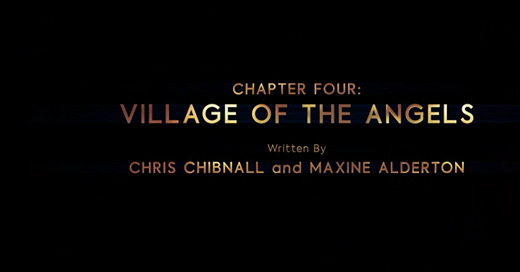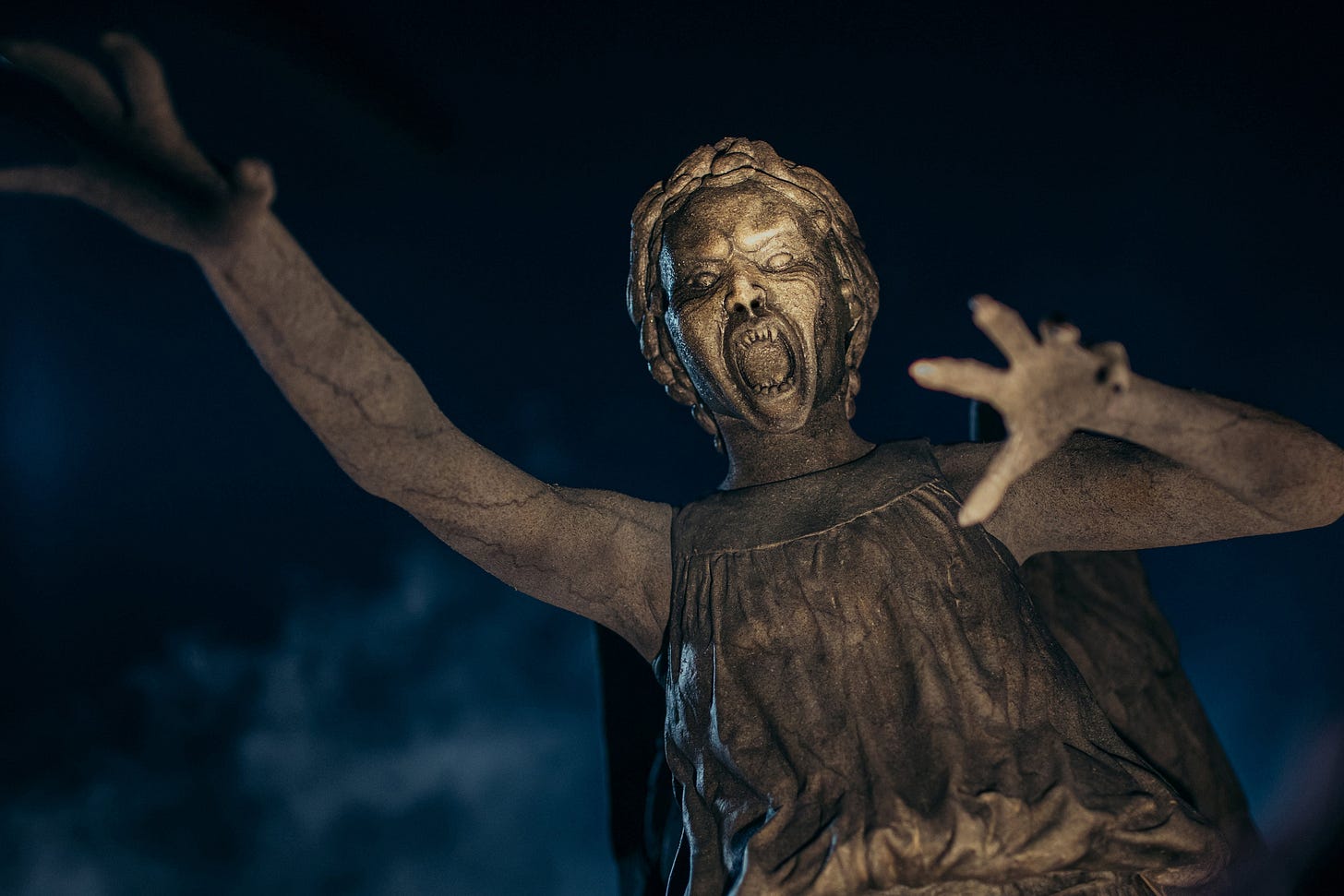They Take a Village
Doctor Who: Flux’s most frightening chapter arrives in “Village of the Angels.”
Note to The Vestibule’s subscribers: My review of Doctor Who: Flux, Chapter Three (“Once, Upon Time”) didn’t find its way to your email inboxes last Thursday (6 January 2022). I’m not certain why, but you may find “Time Out(s)” here. As always, please read, enjoy, and leave a comment. All the best as 2022 begins, Jason
Doctor Who: Flux
“Chapter Four: Village of the Angels”
Series 13, Episode 4
Written by Chris Chibnall and Maxine Alderton
Directed by Jamie Magnus Stone
Starring Jodie Whittaker, Mandip Gill, and John Bishop
Guest Starring Jacob Anderson, Vincent Brimble, Jemma Churchill, Thaddea Graham, Jonny Mathers, Penelope McGhie, Kevin McNally, Poppy Polivnick, Rochenda Sandall, and Annabel Scholey
56 minutes
Original broadcast 21 November 2021
1. Chills & Thrills
For viewers who thought that Doctor Who: Flux topped out early, in its second chapter (“War of the Sontarans”), Series 13’s fourth episode—the ominously titled “Village of the Angels”—would like a word.
And that word, to quote Christopher Eccleston’s redoubtable Ninth Doctor, is “Fantastic!”
Yes, dear reader, Team TARDIS continues its winning streak with an entry that returns the Weeping Angels to their terrifying roots as implacable, relentless, and unsettling foes. The Angels are among ex-showrunner Steven Moffat’s greatest contributions to New Who lore, having been introduced in Series 3’s classic 2007 installment “Blink,” starring David Tennant’s Tenth Doctor, before being brought back frequently enough during the Eleventh Doctor’s (Matt Smith’s) tenure that their power to frighten viewers became diluted, indeed so adulterated that their appearance in Smith’s final episode, 2013’s Christmas Day Special “The Time of the Doctor,” was relegated to two brief cameos, the last of which played the Weeping Angels for laughs.
This jokey reference might be Moffat’s beleaguered confession that, yes, he’d diminished the forbidding reputation of these quantum-locked creatures, who turn to stone whenever observed, to the point that quips were all that remained, making Moffat’s decision to keep Peter Capaldi’s Twelfth Doctor from facing the Angels as a major nemesis during Series 8, 9, and 10 a wise move (even if a single Weeping Angel briefly appears in Series 9’s finale, “Hell Bent”).
Chris Chibnall includes a solitary Weeping Angel as the Thirteenth Doctor’s (Jodie Whittaker’s) fellow inmate in the Judoon prison that confines them both during the early scenes of “Revolution of the Daleks,” the 2021 New Year’s Day Special. Nicknaming this cellmate “Angela” is the extent of any humor about the Weeping Angels that this episode hazards, meaning that faithful New Who viewers shouldn’t reproach themselves for overlooking the Angels as a threat (big or small) to Whittaker’s incarnation of Doctor Who’s protagonist. Ever since Moffat left them behind in Series 7’s “The Angels Take Manhattan,” the once-fearsome antagonists seemed little more than a relic of Moffat’s time as New Who’s showrunner, as well as fictional creations that the British Broadcasting Corporation (BBC) had apparently left in his exclusive control.
Consider, for context, that their New Who appearances were all scripted by Moffat. Then-showrunner Russell T. Davies, as Moffat reveals during his audio commentary for “Blink” (included in the Series 3 Blu-ray and DVD box sets), made few suggestions about Moffat’s script due to “Blink’s” tight shooting schedule, meaning that Moffat’s teleplay was put into production almost immediately after he submitted his second draft, leaving time for only one script meeting in an era when three or four were normal.1 The Angels’ only television appearance not written by Moffat before “Village of the Angels,” moreover, comes during “The Lost,” the series finale of 2016-2017’s one-season spinoff Class. Written by Patrick Ness, this entry (like each one of this short-lived program’s eight episodes) was supervised by Moffat.
So, when another Weeping Angel pops up in Flux’s first chapter, “The Halloween Apocalypse,” to menace a woman named Claire (Annabel Scholey), audience members may be forgiven for thinking this cameo is merely a scare tactic or a throwaway moment that Chibnall includes to jolt each viewer’s adrenaline, even if the Angel follows Claire home and attacks her just before she gets inside, thereby sending her into the past.
As such, the appearance of a Weeping Angel during Flux’s third chapter, “Once, Upon Time,” comes as a mild surprise that rapidly escalates to serious danger when it threatens Yasmin “Yaz” Khan (Mandip Gill), who barely manages a last-minute escape in a development that cannot fully prepare us for the shocking revelation, in “Once, Upon Time’s” final moments, that this same Weeping Angel boards the TARDIS, grabs its controls, and highjacks the Doctor’s plans to end the Flux once and for all.
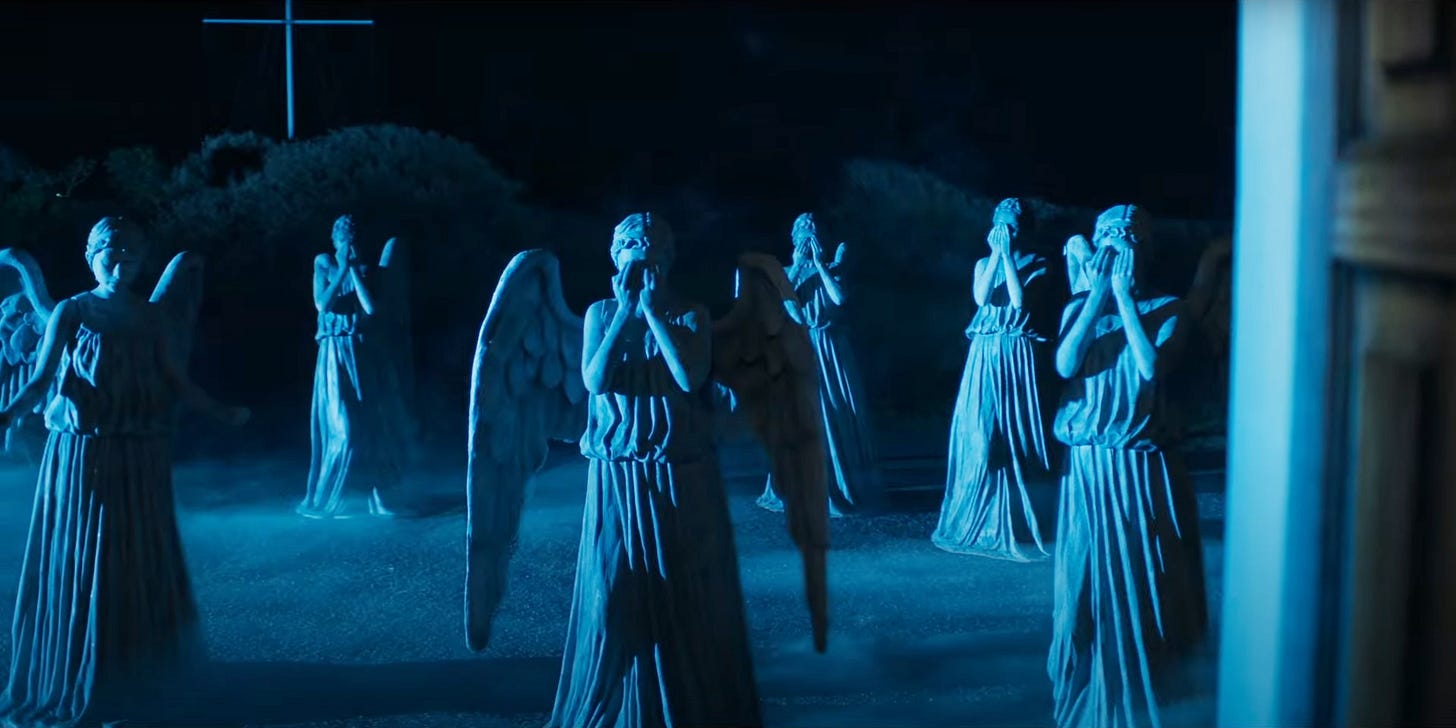
2. Thrills & Chills
“Village of the Angels,” therefore, marks the second time that Chibnall appropriates an extraterrestrial species created during the Davies era for his own purposes. Just like the Judoon in Series 12, Chibnall here builds on everything that has come before to fashion a story calibrated for his own preferences and concerns, which could not have been easy given Moffat’s commitment, during his time as showrunner, to widening the Weeping Angels’ backstory.
Whereas the Angels were terrifyingly, mysteriously silent in “Blink” (or, more properly, terrifying and mysterious because they remained silent), Moffat expands their background by giving the Angels the ability to speak in (and through) their victims’ voices in Series 5’s first two-part installment, “The Time of Angels” / “Flesh and Stone.” Not only that, he also introduces the concept that the image of an Angel, if watched or contemplated long enough, becomes an Angel itself, allowing any rendering of an Angel (be it sketch, painting, photograph, or even live-video feed) to spring to life as the plot demands.
The fact that neither the Tenth Doctor (David Tennant) nor Sally Sparrow (Carey Mulligan), the woman who first encounters the Weeping Angels in “Blink,” mentions this fact is not necessarily a plot hole, either. Even if Sparrow, at “Blink’s” conclusion, hands the Tenth Doctor a dossier with photos of Weeping Angels (that might seem to endanger him in all sorts of ways), she never encounters this specific problem, making the Tenth Doctor’s choice (to withhold information about the danger that Angel images pose) a clever, or at least sensible, ploy to prevent overwhelming Sally with details that might distract her from the immediate threat she faces.
The likeliest explanation, of course, is that Moffat hadn’t fully developed the Angels’ history when circumstances forced him to complete “Blink’s” teleplay in only a few days. Then, when time came to bring back his star monsters after winning the 2008 Hugo Award (for Best Dramatic Presentation, Short Form) for “Blink,” Moffat found it necessary to refine the Angels’ abilities in greater detail to justify their inclusion in not one, but two Series 5 installments.
“Fair enough,” we might say, but Moffat’s decision to return the Weeping Angels to our screens in “The Angels Take Manhattan” received backlash from fans after this installment’s initial 29 September 2012 broadcast, mostly for depicting the Statue of Liberty as a Weeping Angel in a moment that, while undeniably powerful, remains perplexing enough that no amount of head scratching can explain it.
Moffat then allows another, errant Angel to send the Eleventh Doctor’s companions, Amy Pond (Karen Gillan) and Rory Williams (Arthur Darvill), back in time (to the year 1938, to be precise), where they must live from that point forward and, to prevent a temporal paradox from destroying New York City, never see the Doctor again. This ending provides a convenient double-exit for two characters who had journeyed alongside the Eleventh Doctor since his introduction in Series 5’s excellent premiere episode, “The Eleventh Hour,” but, by doing so, Moffat falls prey to the temptation to drink from the Weeping Angel well once too often.
Chris Chibnall, given this history, assigned himself a tremendous challenge by granting the Weeping Angels starring roles in Flux’s fourth chapter, but his success in making “Village of the Angels” the best Flux installment yet is cause for celebration.
3. Things That Go Bump…
Chibnall, for the first time in Flux, co-writes Chapter Four with someone else, in this case Maxine Alderton, whose solo work on the teleplay for Series 12’s “The Haunting of Villa Diodati” demonstrated just how well she could create a spooky storyline full of engaging personalities. “Village of the Angels,” as a result, includes remarkably tense scenes of the Thirteenth Doctor, her companions, and its guest characters enduring Weeping Angel attacks that, if they don’t send viewers diving behind their sofas in the best Doctor Who tradition, at least cause certain audience members (i.e., myself) to grip those couch’s arms tighter as the Doctor feverishly tries to save everyone from doom while determining why she, Yaz, and new companion Dan Lewis (John Bishop) were brought to the small English village of Medderton, located on the Devonshire coast, in the year 1967.
Chibnall and Alderton begin this installment by revealing that Claire’s surname is Brown and that, after being assailed by the Angel in “The Halloween Apocalypse,” she was transported back to 1965. Two years later, she participates in paranormal research conducted by Professor Eustacius Jericho (Kevin McNally), who hooks Claire to a lie detector while questioning her about gloomy premonitions that, Jericho hopes, will reveal how such psychic phenomena work. The machine flags as false Claire’s belief that the year is 1967, but as true her utterance that she was born in 1985. Claire quickly corrects this last “mistake” (by saying she was born in 1935), but leaves Jericho flummoxed that she, a woman whom he clinically calls his “percipient,” is confused about significant dates in her own life. This confusion turns to shock when Claire spasms, then speaks in a deep, unnatural voice that declares, “The Angel has the TARDIS.”
How Claire can possibly know this fact proves significant to Chapter Four’s resolution, but the manner by which Chibnall and Alderton set up “Village of the Angels” reminds longtime viewers of “Hide,” the excellent Series 7 entry written by Luther creator Neil Cross (and inspired by Shirley Jackson’s The Haunting of Hill House) that sees a male researcher named Alec Palmer (Dougray Scott) investigating strange happenings in a haunted house with the help of his psychic assistant, Emma Grayling (Jessica Raine). “Village of the Angels” riffs on this premise by making its drafty domicile Professor Jericho’s property and its female psychic into Jericho’s test subject, with both characters becoming accidental assistants to the Thirteenth Doctor when she discovers their experiment just as groups of Weeping Angels arrive to assault Jericho’s house from all sides. Barricading themselves into Jericho’s basement provokes hasty attempts to fend off wave after wave of Angel attacks whose frenetic scares are skillfully staged by director Jamie Magnus Stone.
Yaz and Dan, meanwhile, help the local townsfolk search for a missing girl named Peggy (Poppy Polivnick) soon after they arrive in Medderton, landing there only because the Doctor successfully uses a massive TARDIS cable to “reboot” her timeship and expel its Angel highjacker. The Doctor then asks Yaz and Dan to find Peggy, whose disappearance seems fishy, before trotting off to Jericho’s house. Both companions, after encountering Peggy’s irritable (and instantly unlikeable) great-uncle, Gerald (Vincent Brimble), and his long-suffering wife, Jean (Jemma Churchill), find themselves in an empty, foggy, nighttime field where another Weeping Angel lies in wait.
Chibnall and Alderton do not allow Yaz and Dan to engineer a clever escape from this predicament. Instead, the Angel attacks and propels them backward in time, to Medderton in the year 1901. The village of this era seems abandoned, yet Yaz and Dan soon locate ten-year-old Peggy, who not only understands that she was sent there by an Angel attack but also takes them to a roadway just outside Medderton that—in an astounding sight that marks a victory for Doctor Who’s visual-effects team—opens onto the twinkling starscape of deep space.
Yes, that’s correct: Yaz and Dan stand before the astonishing view of the roadway stopping and sheering downward, with chunks of rock and debris falling away, as if the entire village has been scooped from the ground and placed inside a bubble floating in space. Even worse, Peggy says this bubble is contracting and will eventually crush everything inside. This head-spinning predicament explains how and why Medderton’s 1901 residents, as Peggy learns in her local-history class (while still living in 1967), will never be seen again. Yaz and Dan soon realize that they may be trapped in 1901 with no way to return to 1967 (much less 2021), meaning that, unless they discover some way to contact the Doctor, they and Peggy are fated to die.
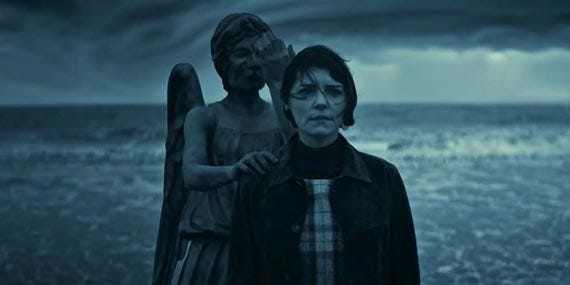
4. Angel Eyes
Back in 1967, however, matters spin out of control. The Doctor succeeds in jury-rigging a television set (so that Jericho can monitor the Angels’ progress breaking into his house) while she links minds with Claire to understand how Claire can speak with an Angel’s voice and what her (Claire’s) visions of turning to stone mean. For Claire, becoming an Angel is a terrifying prospect, as it would be for anyone, but the Doctor discovers that, in fact, Claire’s mind is possessed by a rogue Angel fleeing an “extraction squad” of fellow members employed by Division, the temporal black-ops agency that erased the Doctor’s memories of being the Timeless Child. This Rogue Angel, moreover, claims to have information about all Division activities, including details about the Doctor’s life as the Timeless Child and as the Fugitive Doctor.
As dramatic reversals go, this one is irresistible to audience members willing to follow Chibnall’s by-now staggeringly complicated Timeless Child storyline, which “Village of the Angels” reveals to be less a line than a branching tree whose limbs all bear unnerving implications. I sympathize with viewers who proclaim such intricacies too tough to track, much less care about, but find myself increasingly fascinated as Chibnall (with Alderton’s assistance) adds new layers to this storyline’s mythology.
What, however, is the upshot? Taking refuge inside Claire’s mind gives her Rogue Angel leverage to demand that the Doctor save it from capture. Annabel Scholey, by adroitly alternating Claire’s fear with the Rogue Angel’s confidence, gives a superb performance here and throughout “Village of the Angels.” Division’s extraction squad soon breaks into Jericho’s basement, forcing him to revive the Doctor and Claire so they can all attempt escape through a tunnel leading to the surface.
This sequence, in which the Doctor, Claire, and Jericho tag-team each other—with two people keeping their eyes on the Weeping Angels that have invaded the tunnel while the third person moves forward—becomes a master class in suspense filmmaking, with director Jamie Magnus Stone ratcheting the tension so high that Whittaker, Scholey, and Kevin McNally deserve plaudits for playing their characters’ simultaneous fear and resolve so well.
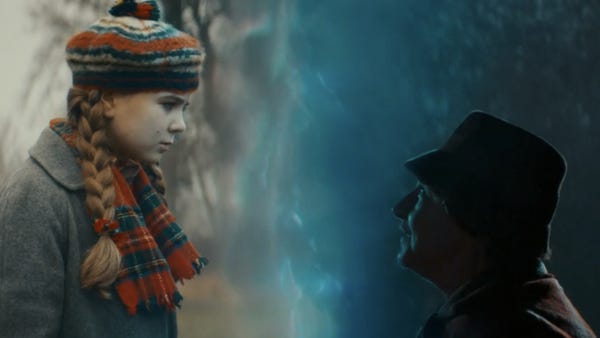
Jericho, however, is caught and sent back in time to 1901 Medderton, where he finds Yaz, Dan, and Peggy facing a split in spacetime whose boundary cleverly mimics the visual technique of a split screen, making it an existential reality for all four characters, who, while standing in the daylight of 1901 Medderton, can look across the boundary into 1967 Medderton, where night has fallen and where village resident Mrs. Hayward (Penelope McGhie) comes into view. Hayward, in a moment of startling force, says that she remembers these events because she is, in fact, Peggy 66 years in the future. The revelation that Peggy remains living in Medderton for nearly seven decades, never escaping her forced trip to the past, gives “Village of the Angels” an unexpected poignancy that viewers have scant time to appreciate once the Doctor and Claire arrive on the 1967 side, where a more dreadful disclosure awaits.
Medderton, you see, includes a burial site that supposedly dates from the Stone Age, but that Peggy knows appeared in 1901 just as the Weeping Angels displaced or killed all the village’s residents. Claire, now fully possessed by her Rogue Angel, enjoys watching the Doctor work out the Angels’ plan: the extraction squad removed Medderton from space and time to trap the Doctor, not Claire. Several dozen Weeping Angels join Claire atop the “burial site,” which is in fact the extraction squad’s transport, bringing chilling resonance to the Rogue Angel’s earlier words: “Division uses everything and everyone. Every species, every world, every moment. They are everywhere, present and unseen.” The possessed Claire, in other words, is a decoy whose plight fiendishly plays upon the Doctor’s sympathies, allowing the Angels to use her own best qualities against her.
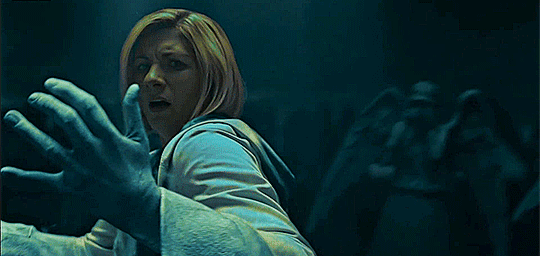
Then, in Flux’s best climax yet, Claire says, “You are recalled to Division” and we watch, slack-jawed, as the Doctor transforms into a Weeping Angel. Yes, friends, Chibnall and Alderton go for broke here, taking their Weeping Angels’ storyline to the absolute limit by making the Doctor a member of this formidable species. As her body calcifies, a pair of stone wings grows from the Doctor’s back while stone hands cover her eyes.
This short sequence is remarkable to watch, even as it prompts us to ask: How much sense does this development make? How will the Doctor evade this quandary? Only time and Flux’s final two chapters will tell, but, for me, this conclusion is the sort of heart-stopping climax that New Who has always excelled at delivering. Jamie Magnus Stone’s direction, Jodie Whittaker’s performance, and Segun Akinola’s music—along with the stellar visual-effects work—help fashion a final sequence of resounding horror that leaves me panting for more.
As perfectly pitched as this resolution may be, Chibnall’s constant raising of Flux’s stakes now requires him to weave its twists, turns, and shocks into a satisfying tapestry that pays off as many moments like this one as possible—lest they seem, in retrospect, gratuitous attempts to compound the viewer’s stress.
Yet what a wild, rollercoaster ride Chibnall and Alderton provide in “Village of the Angels.” This installment is exhilarating, finely wrought, and, for my money, an instant classic. It’s also the best Weeping Angels story since “Blink” premiered 10 seasons—and 14 years—before.
So, huzzah to Chris Chibnall, Maxine Alderton, the cast, and the crew for renewing our faith that the Weeping Angels are the stuff of nightmares, for keeping us on the edges of our seats, and for making “Village of the Angels” Flux’s finest chapter yet.
FILE
NOTE
Moffat’s audio commentary for “Blink,” available in the Doctor Who Series 3 Blu-ray and DVD box sets, includes so many fine anecdotes about this episode’s production that it requires more than one viewing to appreciate. The most extensive information about “Blink’s” genesis and filming can be found in the chapter devoted to it in 2007’s Doctor Who Magazine Special Edition: The “Doctor Who” Companion—Series Three.
Moffat offers further comments in several 2017 articles devoted to celebrating “Blink’s” tenth anniversary. See Cameron K. McEwan’s respective 7 June 2017 and 7 July 2017 Doctor Who TV articles “Doctor Who Stars, Writers and Fans Celebrate Ten Years of ‘Blink’” and “10 Years On—Steven Moffat Looks Back on ‘Blink,’” as well as Athena Le’s 3 November 2020 Screen Rant article “Doctor Who’s ‘Blink’ Episode Originally Ended Different for Sally Sparrow.”

